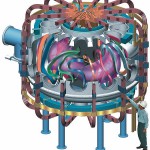[An updated treatment of some of this material appears in Chapter 15 of the Energy and Human Ambitions on a Finite Planet (free) textbook.]
 Ah, fusion. Long promised, both on Do the Math and in real life, fusion is regarded as the ultimate power source—the holy grail—the “arrival” of the human species. Talk of fusion conjures visions of green fields and rainbows and bunny rabbits…and a unicorn too, I hear. But I strike too harsh a tone in my jest. Fusion is indeed a stunningly potent source of energy that falls firmly on the reality side of the science fiction divide—unlike unicorns. Indeed, fusion has been achieved (sub break-even) in the lab, and in the deadliest of bombs. On the flip side, fusion has been actively pursued as the heir-apparent of nuclear fission for over 60 years. We are still decades away from realizing the dream, causing many to wonder exactly what kind of “dream” this is.
Ah, fusion. Long promised, both on Do the Math and in real life, fusion is regarded as the ultimate power source—the holy grail—the “arrival” of the human species. Talk of fusion conjures visions of green fields and rainbows and bunny rabbits…and a unicorn too, I hear. But I strike too harsh a tone in my jest. Fusion is indeed a stunningly potent source of energy that falls firmly on the reality side of the science fiction divide—unlike unicorns. Indeed, fusion has been achieved (sub break-even) in the lab, and in the deadliest of bombs. On the flip side, fusion has been actively pursued as the heir-apparent of nuclear fission for over 60 years. We are still decades away from realizing the dream, causing many to wonder exactly what kind of “dream” this is.
Our so-far dashed expectations seem incompatible with our sense of progress. Someone born in 1890 would have seen horses give way to cars, airplanes take to the skies, the invention of radio, television, and computers, development of nuclear fission, and even humans walking on the Moon by the age of 79. Anyone can extrapolate a trajectory, and this trajectory intoned that fusion would arrive any day—along with colonies on Mars. Yet we can no longer buy a ticket to cross the Atlantic at supersonic speeds, and the U.S. does not have a human space launch capability any more. Even so, fusion remains “just around the corner” in many minds.
Views: 75702




